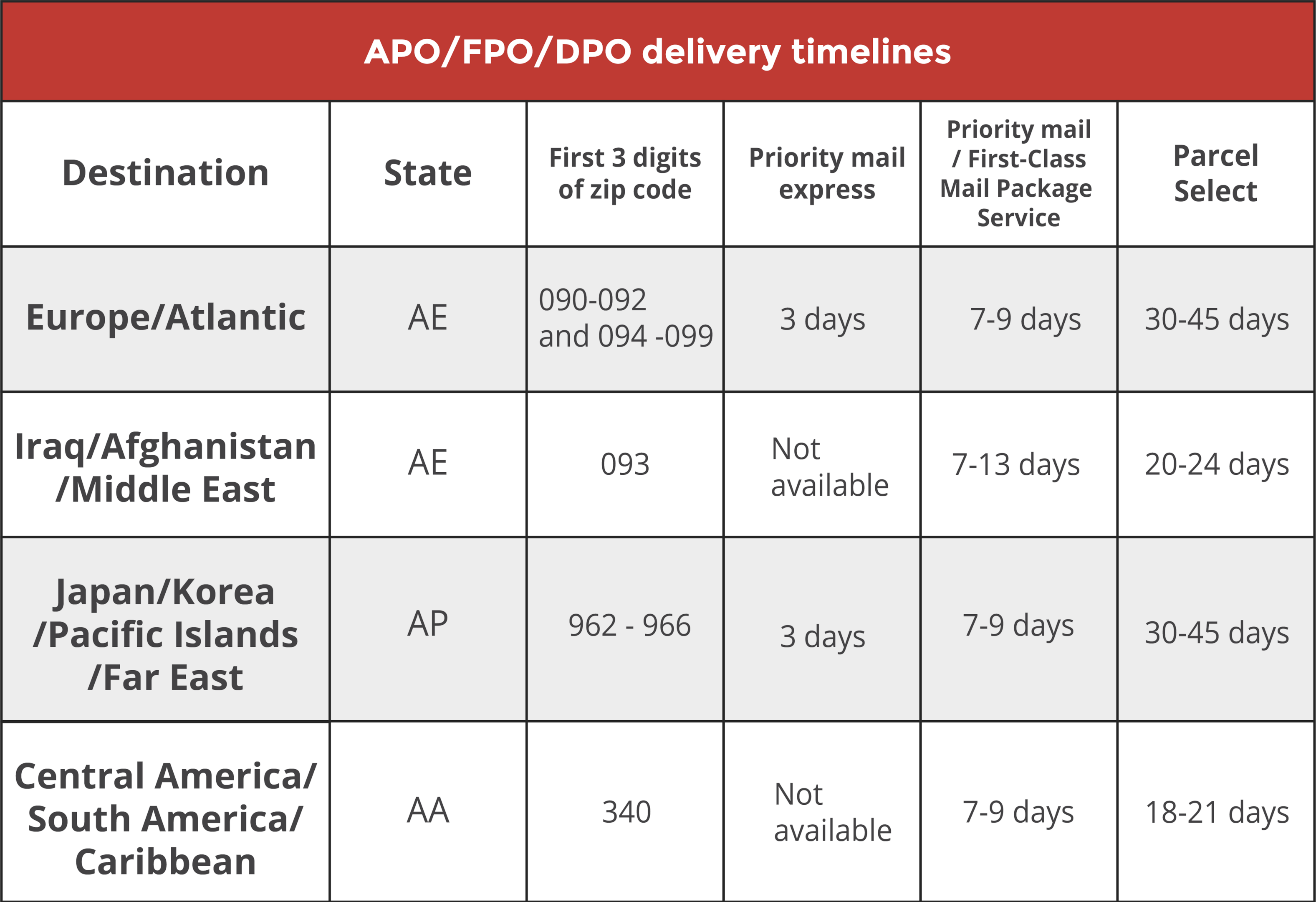If you need to ship products to military personnel, it’s crucial to understand the unique addressing system used by the U.S. Armed Forces. The Army Post Office (APO), Fleet Post Office (FPO), and Diplomatic Post Office (DPO) all have special rules to follow.
Understanding the guidelines for shipping to military addresses so you can save time and make sure your packages reach their intended recipients.
What is APO shipping?
APO shipping is when you ship mail and packages to members of the United States Army or Air Force. The Army Post Office (APO) handles packages for domestic and international delivery. However, there is also FPO and DPO shipping for other military branches.
Defining APO, FPO, and DPO
- Army Post Office: The APO handles packages for Army and Air Force members.
- Fleet Post Office: The FPO handles packages for Navy members. Packages sent to a Fleet Post Office can take the longest to arrive since members are often stationed on ships.
- Diplomatic Post Office: The DPO handles packages sent to U.S. embassies and consulates.
Unlike standard addresses, military addresses do not include a city or state. Instead, they use a unique combination of letters and numbers to identify the specific military branch or ship.
Knowing how to ship APO starts with understanding the unique requirements.
Here’s an example of an APO address.

And, here’s how to decode this address:
- “PFC” is the person’s rank: “Private First Class.”
- “PSC” stands for “Postal Service Center.”
- “APO” specifies the military post office for Army and Air Force members.
- “AE” represents “Armed Forces Europe.”
- The ZIP code “09021” identifies the particular military unit.
Use the correct address format and include all necessary information to make sure your packages reach their destination. Incorrect addresses can lead to delays or even undeliverable packages.
By understanding the unique characteristics of APO, FPO, and DPO addresses, you can streamline your shipping process and provide better service to your military customers.
How APO shipping works
When shipping to an APO address, the United States Postal Service (USPS) is the final carrier, even if you initially use a private shipping company like FedEx or UPS.
Private carriers can transport your package to a USPS hub, who then takes over and delivers it to the military installation.
The USPS is the only postal service that can deliver packages to APO, FPO, and DPO locations.
Routing
When mail is sent to an APO, FPO, or DPO address, it’s initially sent to a central sorting facility in Miami, New York City, or San Francisco.
From there, it’s sorted based on the destination’s two-letter state code (AA, AE, or AP).
State Codes
Be sure to address your packages using the proper state code.
- AA (Armed Forces Americas): This code is used for military installations in the Americas (except Canada).
- AE (Armed Forces Europe): AE is used for military installations in Europe, the Middle East, Africa, and Canada.
- AP (Armed Forces Pacific): AP is used for military installations in the Pacific and Asia regions.
Customs forms
When shipping a package to an international address, you must complete a customs form for smooth processing and delivery. These forms are required for all international shipments, including those to APO, FPO, and DPO addresses.
The most common form is PS Form 2976-A, which requires detailed information about the package contents, value, and recipient’s information.
Restrictions on items
Certain items cannot be shipped to military addresses, with varied restrictions based on the destination country and military branch.
Some common examples of prohibited items include:
- Alcohol and tobacco products
- Aerosol cans and pressurized containers
- Flammable items, like matches or lighters
- Batteries (with some exceptions)
- Perishable items.
For specific restrictions, consult the USPS website, the official postal service of the destination country, or the Military Postal Service Agency (MPSA) website.
Restricted zones or countries
In addition to item restrictions, there may be restricted zones or countries where shipping is prohibited for security or political reasons.
For example, shipping to APO addresses in Iraq or Afghanistan may be limited or prohibited. Stay informed about any restrictions that may impact your ability to ship to certain military destinations.
APO, FPO, and DPO shipping best practices
Shipping to military addresses requires careful attention to detail and adherence to specific guidelines. By following best practices, you can help ensure successful deliveries, prevent delays or damage, and maintain customer satisfaction.
Implement these strategies to optimize your APO, FPO, and DPO shipping process.
- Use accurate address formatting: Include the recipient’s rank, full name, and unit designation. Example: Sergeant John Smith, Unit 1234, Box 5678, APO AP 12345.
- Don’t use city or country names: Prevent mail from entering foreign mail networks by avoiding the use of city and country names in APO, FPO, and DPO shipping.
- Follow proper packaging guidelines: Use sturdy materials like corrugated boxes, seal packages securely with packing tape, and avoid wrapping paper or string to prevent sorting machine delays.
- Choose the right shipping service: USPS First Class Package Service is often affordable for packages under 13 ounces, and USPS Priority Mail and Priority Mail Express provide faster delivery. Compare prices and delivery estimates from FedEx and UPS.
- Consider insurance options: USPS offers insurance for most services, with varying coverage amounts. Priority Mail includes $50 of insurance, with additional coverage available up to $5,000. Check specific policies for APO shipments when using private carriers.
Challenges, considerations, and resources
When shipping to APO addresses (or other military branches), you may face some challenges. Understanding this upfront can help you take steps to ensure a smooth shipping experience.
Potential delays
Communicate realistic delivery expectations to your customers.
- Clearly state that shipping to APO, FPO, and DPO addresses may take longer than standard domestic shipping.
- Provide estimated delivery timeframes based on the destination country and shipping method.
Be proactive in updating customers about any known delays or disruptions.
- Monitor USPS service alerts and inform affected customers promptly.
- Offer alternative shipping options or refunds if significant delays occur.

Source: Stamps.com
Understand the standard delivery times for each military mail zone.
- Refer to the USPS APO, FPO, and DPO Estimated Delivery Times for guidance.
- Delivery times can range from seven to 30 days or more, depending on the destination and shipping method.
Other factors may cause additional delays when shipping APO, FPO, or DPO.
- Customs processing, military logistics, holidays, peak mailing seasons, and local conditions can impact delivery.
Addressing returned packages
Establish a clear process for handling returned APO, FPO, and DPO packages.
- Designate a team member to monitor and process returned packages promptly.
- Contact customers to verify their address and arrange for reshipment or refund.
Analyze returned packages to identify common issues and improve your shipping processes.
- Look for patterns in incorrect addresses, packaging problems, or customs issues.
- Implement measures to prevent future returns, such as address verification or enhanced packaging.
Tax considerations
Be aware of state sales tax exemptions for APO, FPO, and DPO shipments.
- Many states exempt military shipments from sales tax.
- Consult your state’s tax authority for specific guidelines and requirements.
Understand potential customs duties for recipients.
- Some countries may impose customs duties on incoming packages.
- Advise customers to check with their local military mail office for information on customs fees.
Mitigating package loss
Take preventive measures to reduce the risk of lost packages.
- Use tracking services to monitor your shipment’s progress.
- Ensure high-value items to protect against loss or damage.
Know how to report missing APO, FPO, and DPO packages.
- Contact the USPS Military Mail Inquiry Center for assistance with missing packages.
- Provide customers with instructions on how to report missing packages through official channels.
Streamline APO shipping with Red Stag Fulfillment
At Red Stag Fulfillment, we understand the unique challenges and considerations that come with shipping to APO, FPO, and DPO addresses. Our team of experienced professionals stays up to date with the latest military shipping regulations and best practices, allowing you to focus on growing your business while we handle the complexities of APO shipments.
From accurate customs declarations to secure packaging and reliable tracking, we provide end-to-end solutions tailored to your specific needs.
Contact Red Stag Fulfillment to learn more about our military shipping solutions and how we can help streamline your APO process.











